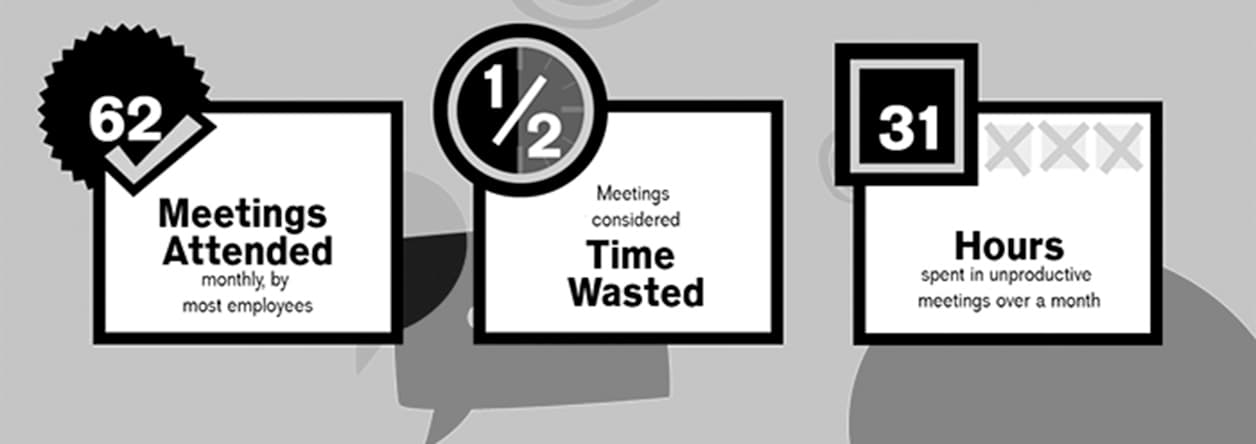Did you know you spend 20% of your work life in unproductive meetings?
Well hopefully, your average is lower!
Atlassian research shows that employees spend an average of 31 hours in unproductive meetings over the course of a month. That's almost a fifth of the time an individual spends at work. Given that meetings are an essential and frequent part of the workday, the question that naturally arises is how to optimize the time spent in meetings.
To maximize your time during meetings, adopt a strategic approach in structuring your meeting. With thoughtful planning, you can cut down on the amount of time that you and your team members spend in meetings and yield better results during your time together. Here are tips to develop and drive more effective meetings.
Develop Meeting Structure
A productive meeting starts before you ever enter the room together. Once you have outlined what you want to achieve during the meeting, spend time figuring out how you are going to accomplish your meeting objectives. The goal here is to create a concise meeting agenda that will optimize the actual time your team spends together as a group. Start by working through these facets:
- Goals and discussion points: List out what goals you want to execute and main talking points you want to address with your team.
- Attendee list: Based on what you are trying to achieve, distill the attendee list. Who are the driving contributors and who is impacted directly or indirectly by the meeting content? If someone will be minimally impacted by the decisions made, decide if they need to be present at the meeting or if they can they be caught up to speed from the meeting minutes or a coworker.
- Item time frames: Consider the scope of each agenda team and calculate the appropriate amount of time for each discussion point.
- Meeting time frame: Add up the times allotted for the agenda items, factoring in additional time for questions to set the total duration of the meeting.
- Discussion order: Arrange the order of your discussion points based on priority and how many people need to be involved for each portion of the discussion. Let's say you are running an interdepartmental meeting with 9 people. If there are three discussion points where only 7 members are needed, arrange the item order so that those three points are addressed last in the meeting. Allow the 2 members who aren't involved for the whole meeting to depart after their relevant discussion points.
- Meeting roles: Assign roles for specific attendees based on who will be present for the entirety of the meeting. Roles may include:
- Recorder: Writes down major decisions, executable tasks, next steps, and a summary of what was covered.
- Timekeeper: Helps the facilitator manage the time based on established time frames, giving alerts to resolve a discussion point or decide to table it if time is running low for a particular section.
- Facilitator: Moves the meeting along, which is done by asking, listening, and ensuring that the meeting is kept on track. While it’s the facilitator’s duty to keep the meeting moving forward, each topic should be fully closed out before moving on to the next one.
- Attendee pre-work/materials: Determine and assign work that needs to be completed individually beforehand. For example, do team members need to complete a form for a project retrospective meeting?
Once you have worked through these elements, the next step is to compile an agenda that outlines the meeting for your employees. This doesn't mean that you have to design an agenda from the ground up. Several platforms make it easy for you to plug in your meeting info, such as Cisco Spark, Minute, and Worklife.
Once your agenda is finalized, email it to all attendees to see if they have any time or content adjustments. Don't forget to send out other handouts or relevant materials they should review before the meeting.
Drive Efficiency and Relevancy
Now that all of your planning is complete, you're ready for the meeting to begin. Be sure to stay focused on the main objective of the meeting, keep it on track, and make each attendee feel valuable to the matter at hand. As you kick off the meeting, keep these things in mind:
- Energy and purpose: Get the meeting started off with an enthusiastic greeting to rally employees and keep up the energy level. Reiterate the meeting objective so that it is at the forefront of everyone's mind.
- Beginning of meeting: Start on time and if people arrive late, try not to take time out of the meeting to catch them up. Don't encourage tardiness or waste time with unnecessary repetition.
- Ground rules: With the exception of extraneous circumstances, don't allow for scope creep or for attendees to check emails or complete outside work during the meeting. If an important digression arises, take note and table it for the future.
During the heart of the meeting, follow the agenda and have each team member fulfill their roles so you can accomplish your goal. Additionally, keep members engaged and communicate that they are valued in the discussion by focusing on:
- Participation: Each person’s input is valuable and attendees should listen respectfully and attentively to one another. Based on everyone's strengths, make sure to get input from everyone throughout the meeting, especially those who may normally be less inclined to speak up. Give everyone ample time to share their thoughts and ideas. With a low Assertiveness score, which means that I err on the side of being suggestive and non-confrontational in my communication, I'll usually offer meeting contributions when there is a lull in conversation as opposed to interjecting while there is ongoing conversation. Some of my team members have a high Assertiveness score, meaning that they tend to be verbally dominant and share opinions easily. Over the past year, our team has found a balance between the different personality types to allow opportunities for open conversation that includes all meeting members.
Meeting environment: How does each person communicate and how do they like to be addressed? Do they prefer more direct or suggestive communication if you are addressing them individually? Would individuals feel "put on the spot" to come up with a quick decision and prefer more time to contemplate? As someone with a high Thought score (this means I prefer time to work through ideas and consider all options before coming to a decision), I find it helpful if I have ample time to consider a problem or project before gathering with a group to discuss it. This way, I can come to the meeting prepared with ideas. It was helpful when my manager gave me a few days heads up about a recent brainstorming session, allowing me to come to the meeting prepared with strong contributions. Do what you can to understand the preferences of the meetings members and shape the meeting environment so that each member feels comfortable contributing to the discussion. You can check out this great blog for ideas on how to lead a team with diverse personalities!
Assigning tasks: As needs arise during the meeting, make sure to take note of any actions items that need to be completed. Make a point to assign tasks during the meeting based on your team member's strengths and bandwidth. This can help engage attendees and make them feel more invested in the overall goal that you are trying to achieve.
Finally, end the meeting on time. Adhering to the time limit encourages efficiency and relevancy in discussion.
Capitalize on Your Efforts
As you conclude the meeting, you should be able to answer the goals you set out to achieve or know where you are in the process towards achieving those goals. As you wrap up, capitalize on all the hard work you've already put into the meeting. Create and distribute (within 24 hours) a unified record of what you accomplished and discussed. I've found that creating post-meeting documentation helps lessen confusion on what was discussed and drives people to complete the next action steps. Make sure to include:
- Meeting minutes
- Status of goals
- Takeaway tasks
- Topics to cover at the next meeting
- "+2/-2": Have each meeting member submit two things that went well during the meeting and two things that could use improvement. Keep this feedback in mind to continually refine meeting efficiency.
From the moment you schedule a meeting to the improvements that you document afterwards, these may seem like a lot of steps and elements to keep track of. However, if you are consistent in following this process, it will become ingrained and you'll find that the long-term payoffs are high! Watch how meetings become streamlined and communication more effective through these tips.
Reaching Further
Like anything that incorporates interacting with other people, much of what makes meetings successful is knowing who is present. When you have an accurate understanding of your coworkers, you will be able to better facilitate and tailor your meetings to best meet the needs of your team members. Personality assessments like The Birkman Method can help give you a better understanding of the factors that play into your workplace interactions, such as communication styles and work style preferences. The Birkman Method is a robust tool that goes past how people are viewed by those around them, and dives into what people need from their environment in order to be successful. With this knowledge, team members can help create a workplace that is supportive to each member's needs, and helps set up the team for success.

